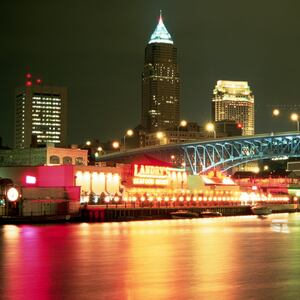Rep. Marcia Fudge’s nomination to become the Secretary of Housing and Urban Development connects so many historical and civil rights dots that even the Biden transition team likely is unaware of its masterstroke. Rep. Fudge, Democrat of Ohio, can play a vital role in collapsing a half a century of neglect of our urban areas—a time that can be traced back to 1968, when then-Vice President Hubert Humphrey, running for president, visited Cleveland to advocate for a Marshall Plan for America’s cities.
It was only a few weeks ago that eight mayors of cities in Ohio, Pennsylvania, West Virginia, and Kentucky penned an op-ed in The Washington Post calling for a “Marshall Plan for Middle America,” though odds are that even these mayors were unconscious of the deep history into which they were tapping. The reference to a Marshall Plan, of course, was to the Truman Administration’s immense investment in rebuilding Europe after World War II.
Fudge comes from Ohio’s 11th congressional district (redistricted from the 21st congressional district), which consists of the largely Black east side neighborhoods and suburbs of Cleveland.
ADVERTISEMENT
She stands on the shoulders of the Stokes brothers, creators of a political dynasty. Louis Stokes held the 11th district seat for 15 terms, the first African American elected to Congress from Ohio. In 1967, his brother Carl was the first African American to be chosen as mayor of a major U. S. city. Lawyerly and charismatic, Carl appeared on the covers of Time and Newsweek, a true forerunner to Barack Obama.
Cleveland in 1967 was the eighth largest city in America, and it was in trouble. Like so many northern urban areas, Cleveland had seen a tremendous influx of African Americans from the South during the two great migrations that followed the world wars of the 20th century.
Because of restrictive housing deeds, redlining mortgage restrictions by banks, and the open hostility from whites that often led to violence, Blacks were crowded into neighborhoods where schools were poor, sanitation inferior, jobs scarce or vastly underpaying, and the housing stock deteriorated. Steady police abuse prevailed in Black areas like the Hough and Glenville neighborhoods.
This pattern of official neglect and police repression was repeated throughout America in areas like Watts in Los Angeles, Detroit, Chicago, Newark, and scores and scores of other cities and towns. Rioting, looting, and rebellion took a dramatic toll on urban neighborhoods.
The Johnson Administration tried to address the urban predicament with its Great Society programs and the so-called “war on poverty.” At the same time, though, President Johnson became mired in the Vietnam war and consequently, focus was lost on the battle against racism and poverty.
Any steps forward, like LBJ’s appointment of a presidential commission to study the root causes of urban violence, known as the Kerner Commission, were regularly and steadily undercut by more violence.
America faced a vicious cycle—conditions led to violence, violence led to reform efforts that were too little and too late, more violence followed, and eventually a great backlash, one that started with Richard Nixon in 1968, took hold and ended or stunted reform efforts altogether.
Cleveland’s case was a microcosm of the nation. In 1965, the incumbent mayor, Ralph Locher, a lawyer and conservative Democrat who was born in Romania, barely survived a primary challenge from Carl Stokes. Then, in the hot summer of 1966, after a confrontation between bar owners and Black patrons, Hough erupted in four days of rebellion with widespread looting and destruction of predatory businesses and the shooting deaths of four African Americans by police. The National Guard was called out.
Locher came under withering fire from the Department of Housing and Urban Development for his inept handling of federal funds. An article on the front page of The Wall Street Journal in March 1967 called Cleveland a “Racial Powder Keg,” and profiled Locher’s failures in urban redevelopment. HUD put a hold on funding until the mayor and city got their acts together.
The timing was perfect for Stokes. Dr. Martin Luther King Jr. made it his mission to come to Cleveland beginning in the spring of 1967 to help with voter registration drives. Dr. King saw Cleveland as potentially transformative, moving the nation from the long struggle for civil rights and voting rights to an era of Black political power.
King told reporters at the Cleveland Airport in April 1967 that the time had come to transform the moral power of the Civil Rights movement “into political power so that we can bring about the necessary political reforms that will solve the problems that we face.”
On Nov. 7, 1967, Stokes prevailed in a close election (against William Howard Taft’s great-grandson, Seth Taft) and for many, this was a day of jubilee, a substantial barrier broken.
But just five months later, Dr. King was gunned down in Memphis. The next day, Bobby Kennedy, the new frontrunner in the Democratic race for president after LBJ abruptly dropped out just days earlier, came to Cleveland to speak at the City Club of Cleveland. He limited his remarks to 10 minutes, speaking forebodingly of the “mindless menace of violence” that once again stained the land.
Violence was undercutting progress. Two months later, Kennedy fell victim to the mindless violence he decried in Cleveland when he was assassinated in Los Angeles just moments after winning the California primary.
This is when Hubert Humphrey, now himself the frontrunner for the Democratic nomination, made his visit to Cleveland and spoke to the City Club from the same stage that had been occupied by Kennedy just months earlier. Humphrey chose Cleveland to deliver a major campaign address on how his administration intended to handle the vast urban problems facing the nation.
His reason for selecting Cleveland was an anti-poverty plan Carl Stokes created as a memorial fund after King’s death, known as “Cleveland: NOW!” (in homage to King’s slogan in the South, “Freedom: NOW!”).
Cleveland: NOW! started as a modest proposal to fund better housing, jobs, education, health care, and recreation in Cleveland’s neighborhoods, but it quickly morphed into a huge endeavor with the promise of major backing by the federal government. In May 1968, Stokes boasted that he had secured commitments for over $1.2 billion (more than $9 billion today) to be spent in the next 10 years in Cleveland.
Vice President Humphrey, praising Stokes and wearing a yellow “Cleveland: NOW!” button on his lapel, argued to the City Club that the nation needed to follow Cleveland’s model and he called for a Marshall Plan for all cities—the kind of pledge commensurate with the enormity of the problems. Huge dollars needed to be spent.
Twenty days after Humphrey’s speech, a street war broke out between Black Nationalists and Cleveland Police. Ten people, including three police officers, three nationalists, and two bystanders, were killed. A quick investigation revealed that the nationalists had used Cleveland: NOW! funds to buy rifles and ammunition.
The cycle returned. Cleveland: NOW! came to an end, and Carl Stokes himself never truly recovered politically.
Two weeks later, Richard Nixon appeared in Miami Beach to give his dark acceptance speech at the Republican convention, warning of sirens in the street and promising that he would restore order in America as the one true “law and order” candidate.
Nixon won. The war on poverty became the war on drugs. Mass incarceration of Blacks followed. Fifty years later, police killings of Black men caught by phone cameras brought about Black Lives Matter, which in turn helped give rise to the Trump counterrevolution. Paul Manafort, Trump’s campaign manager at the RNC convention in Cleveland in 2016, told reporters that Trump would mimic Nixon’s 1968 when he delivered his “law and order” acceptance speech.
So full circle, Marcia Fudge as the head of HUD has a chance to help reverse this history and to begin anew to address urban issues that in some ways are worse than in 1968. A Marshall Plan type of commitment is needed. The nomination of Rep. Fudge is especially appropriate given Cleveland’s status as one of America’s poorest cities. America must return to its war on poverty and continue the struggle against racism.
James D. Robenalt is the author of four nonfiction books, including Ballots and Bullets, Black Power Politics and Urban Guerrilla Warfare in 1968 Cleveland. He practices law in Cleveland.






